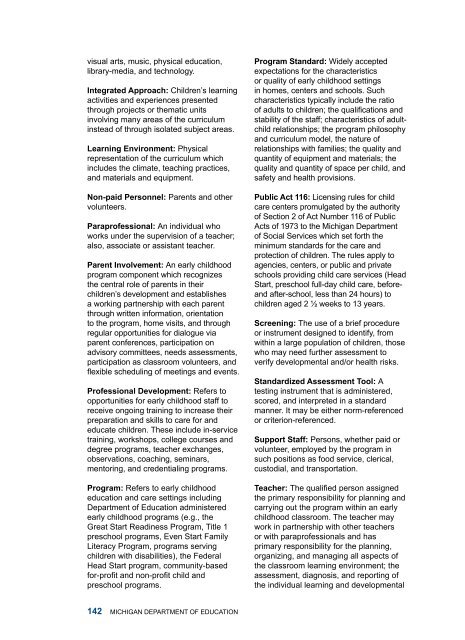Early Childhood Standards of Quality for ... - State of Michigan
Early Childhood Standards of Quality for ... - State of Michigan
Early Childhood Standards of Quality for ... - State of Michigan
Create successful ePaper yourself
Turn your PDF publications into a flip-book with our unique Google optimized e-Paper software.
visual arts, music, physical education,library-media, and technology.Integrated Approach: Children’s learningactivities and experiences presentedthrough projects or thematic unitsinvolving many areas <strong>of</strong> the curriculuminstead <strong>of</strong> through isolated subject areas.Learning Environment: Physicalrepresentation <strong>of</strong> the curriculum whichincludes the climate, teaching practices,and materials and equipment.Non-paid Personnel: Parents and othervolunteers.Parapr<strong>of</strong>essional: An individual whoworks under the supervision <strong>of</strong> a teacher;also, associate or assistant teacher.Parent Involvement: An early childhoodprogram component which recognizesthe central role <strong>of</strong> parents in theirchildren’s development and establishesa working partnership with each parentthrough written in<strong>for</strong>mation, orientationto the program, home visits, and throughregular opportunities <strong>for</strong> dialogue viaparent conferences, participation onadvisory committees, needs assessments,participation as classroom volunteers, andflexible scheduling <strong>of</strong> meetings and events.Pr<strong>of</strong>essional Development: Refers toopportunities <strong>for</strong> early childhood staff toreceive ongoing training to increase theirpreparation and skills to care <strong>for</strong> andeducate children. These include in-servicetraining, workshops, college courses anddegree programs, teacher exchanges,observations, coaching, seminars,mentoring, and credentialing programs.Program: Refers to early childhoodeducation and care settings includingDepartment <strong>of</strong> Education administeredearly childhood programs (e.g., theGreat Start Readiness Program, Title 1preschool programs, Even Start FamilyLiteracy Program, programs servingchildren with disabilities), the FederalHead Start program, community-based<strong>for</strong>-pr<strong>of</strong>it and non-pr<strong>of</strong>it child andpreschool programs.Program Standard: Widely acceptedexpectations <strong>for</strong> the characteristicsor quality <strong>of</strong> early childhood settingsin homes, centers and schools. Suchcharacteristics typically include the ratio<strong>of</strong> adults to children; the qualifications andstability <strong>of</strong> the staff; characteristics <strong>of</strong> adultchildrelationships; the program philosophyand curriculum model, the nature <strong>of</strong>relationships with families; the quality andquantity <strong>of</strong> equipment and materials; thequality and quantity <strong>of</strong> space per child, andsafety and health provisions.Public Act 116: Licensing rules <strong>for</strong> childcare centers promulgated by the authority<strong>of</strong> Section 2 <strong>of</strong> Act Number 116 <strong>of</strong> PublicActs <strong>of</strong> 1973 to the <strong>Michigan</strong> Department<strong>of</strong> Social Services which set <strong>for</strong>th theminimum standards <strong>for</strong> the care andprotection <strong>of</strong> children. The rules apply toagencies, centers, or public and privateschools providing child care services (HeadStart, preschool full-day child care, be<strong>for</strong>eandafter-school, less than 24 hours) tochildren aged 2 ½ weeks to 13 years.Screening: The use <strong>of</strong> a brief procedureor instrument designed to identify, fromwithin a large population <strong>of</strong> children, thosewho may need further assessment toverify developmental and/or health risks.Standardized Assessment Tool: Atesting instrument that is administered,scored, and interpreted in a standardmanner. It may be either norm-referencedor criterion-referenced.Support Staff: Persons, whether paid orvolunteer, employed by the program insuch positions as food service, clerical,custodial, and transportation.Teacher: The qualified person assignedthe primary responsibility <strong>for</strong> planning andcarrying out the program within an earlychildhood classroom. The teacher maywork in partnership with other teachersor with parapr<strong>of</strong>essionals and hasprimary responsibility <strong>for</strong> the planning,organizing, and managing all aspects <strong>of</strong>the classroom learning environment; theassessment, diagnosis, and reporting <strong>of</strong>the individual learning and developmental142 <strong>Michigan</strong> Department <strong>of</strong> Education


